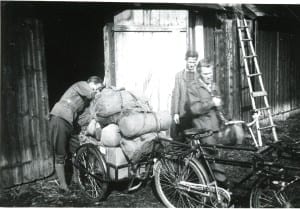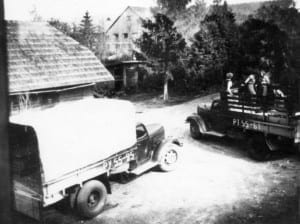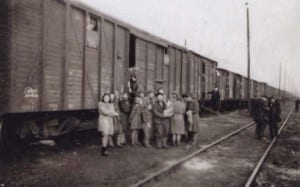Soviets deported over 7,000 women, children, and elderly people from Estonia on June 14 to 17, 1941
A June 14, 2016 Estonian World article is entitled: “Pictures: Deported Estonians in Siberia.”
The opening paragraphs read:
In the summer of 1940, the Soviet Union occupied Estonia, Latvia and Lithuania as a result of the infamous Molotov-Ribbentrop Pact, signed between Nazi Germany and the Soviet Union on 23 August 1939. In the aftermath of World War II, Estonia lost approximately 17.5% of its population.
The Soviet occupation brought about an event that until then had only been read about in history books and which became the most horrible memory of the past centuries – mass deportations that affected people of all nationalities living in Estonia. The two deportations that affected Estonia the most deeply, on 14 June 1941 and 25 March 1949, are annually observed as days of mourning.

Preparations for refugee journey from Estonia in the summer of 1944. A family friend who made a similar journey has remarked it was like jumping out the second storey of a burning building. Photo is from a previous post entitled: “My family fled as refugees from Estonia in 1944.”
The first deportation raid was begun on the night of 13 June and early morning of 14 June. Families who had gone to bed on Friday night with no inkling of anything bad about to happen, were woken up in the early morning hours by pounding on their doors. A decree declaring them to be under arrest or subject to deportation from their homeland without any due process was read aloud to them. All their property was declared to be subject to seizure. They were given an hour to pack.

Boat on which my father and grandfather and other refugees made it across the Baltic Sea in September 1944 during the Second World War. Other family members travelled across the Baltic on a larger vessel. Photo is from a previous post entitled: “My family fled as refugees from Estonia in 1944.”
[End of excerpt]
Comment
Additional photos – in this case related to the 1940s refugee experience – can be accessed at a post entitled:
Previous posts about military history can be accessed here >
Among the family members, who made it to Sweden in September 1944, as described in a previous post (see above) was an aunt and an uncle – a sister and brother of my mother. The aunt and uncle had been on on early 1940s deportation list.
They were saved when their mother was informed, by a person who was aware of the planning of the deportations, that a Soviet truck was on the way to the location where my aunt and uncle, who were of childhood age at the time, were staying. Before the truck or trucks arrived, the ran into a nearby wooded area and remained hidden until the truck(s) were gone.
When I visited Estonia in 1989 and 1990, to do work on behalf of the Estonian Heritage Society, I heard of a case where a motorcyclist had failed to negotiate a turn on a country road. The driver lost his life; a deportation list was found on his body. As I understand, the individuals whose names were on the list were spared, as a consequence of the fatal accident, from deportation to Siberia.
Another story, that I heard during my above-noted visit to Estonia, concerned a child or adolescent who was on a deportation list, but who was walking along a country road when a Soviet truck or trucks arrived at the person’s home. A Soviet agent stopped the person and demanded her or his name. The person made up a name, on the spot, and in that way was, as I understand, spared from deportation to Siberia.
Updates
A June 14, 2016 CBC article is entitled: “Canada considers European troop commitment as CSIS warns Russia is ‘mobilizing for war’.”
From a Facebook post I have learned that the Castel Bianco was among the ships that brought Estonian refugees from Sweden to Canada; a July 2, 2016 Welland Tribune article reads: “Ships That Ply the Lakes: Castel Bianco.” The ship that I travelled on with my family from Sweden to Canada in 1951 was called the Gripsholm.
An Aug. 25, 2016 Quartz Africa article is entitled: ““Nobody is ever just a refugee”: Chimamanda Ngozi Adichie’s powerful speech on the global migrant crisis.”
A Jan. 8, 2017 Estonian World article is entitled: “The UN classifies Estonia as a Northern European country.”
A March 24, 2017 Estonian World article is entitled: “The victims of Soviet deportations remembered in Estonia.”
First Nations peoples
My sense is that First Nations peoples in Canada have in many cases ended up as refugees and deportees. In this context, an Aug. 20, 2016 CBC article is entitled: “Sayisi Dene found ‘utopia’ with 5-day dogsled escape to Tadoule Lake: Defying the government to flee death, destruction and ‘clutches of evil’ at Dene Village.”
An Aug. 22, 2016 Toronto Star article is entitled: “Sixties Scoop survivors’ day in court finally arrives Tuesday: Indigenous Canadians taken from their homes and their culture suing Ottawa, decades later, over the federal government’s duty to them.”



Leave a Reply
Want to join the discussion?Feel free to contribute!